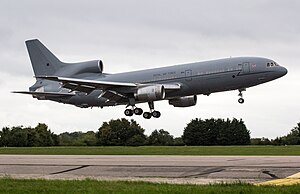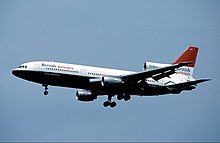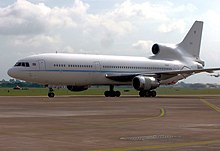| RAF Tristar | |
|---|---|

| |
| RAF Tristar KC1 ZD948 landing at RAF Brize Norton, Oxfordshire, 2013 | |
| Role | strategic tanker / transportType of aircraft |
| Manufacturer | Lockheed Corporation |
| First flight | 16 November 1970 (1970-11-16) (L-1011) |
| Introduction | 24 March 1986 (1986-03-24) |
| Retired | 24 March 2014 (2014-03-24) |
| Status | retired |
| Primary user | Royal Air Force |
| Produced | 1979–1984 |
| Number built | 9 conversions |
| Developed from | Lockheed L-1011 TriStar |

The RAF Tristar is a retired air-to-air refuelling tanker and transport aircraft, formerly in service with the Royal Air Force (RAF). All airframes were retro-converted civilian Lockheed L-1011-500 TriStar airliners, previously operated by British Airways and Pan American World Airways, and entered service with the RAF in 1984.
TriStar aircraft were purchased following the Falklands War as a result of satisfying an urgent operational requirement for four strategic tanker/transport/freighter aircraft had been identified. Of the nine that entered service, the first six were acquired from British Airways with analogue autopilot systems. Four of these were converted into KC1 variants that met the full requirement, with the remaining two converted to K1 standard without a cargo freight door in the front cabin area. The three ex-PanAm aircraft, all with digital autopilts, and after a period of storage, received modifications for military radios and performed a passenger-only role with underfloor freight as C2/C2A variants. Upon entering military service, the RAF dropped the upper-case 'S" when describing their Tristar aircraft.
The KC1 and K1 variant of RAF Tristar formed the air-to-air refuelling fleet of the RAF until replaced by the Airbus A330 MRTT under the Future Strategic Tanker Aircraft (FSTA) programme. The RAF Tristar fleet was retired in 2014.
The RAF Tristars were operated by No. 216 Squadron, and based at RAF Brize Norton in Oxfordshire, England. No. 216 Squadron was officially disbanded on 20 March 2014, and flew its last sorties with the Tristar on 24 March 2014. Three aircraft were scrapped in 2014 for spare parts shortly after retirement. The remaining six aircraft were flown to and stored at Bruntingthorpe Aerodrome, having been purchased by AGD Systems Corp in anticipation of a later sale. The aircraft were being maintained by GJD Systems to a fully airworthy condition, however they have since been scrapped.
Design and development

The Royal Air Force operated nine L-1011-500 TriStars; six ex-British Airways, and three ex-Pan Am. The TriStars were purchased in the immediate aftermath of the Falklands War in 1982 to bolster the long range capability of the RAF in the transport and tanker roles, as the demands of refuelling Hercules supporting forces stationed in the Falklands was rapidly using up the fatigue life of the RAF's Handley Page Victor tankers. A requirement for at least four wide-bodied tanker / transport aircraft was drawn up. At the same time, British Airways wished to dispose of its Lockheed L-1011-500 aircraft, and so put in a joint bid with Marshall Aerospace of Cambridge to supply six TriStars. The initial order for the ex-British Airways TriStars was placed on 14 December 1982; the three ex-Pan Am aircraft were purchased in 1984. All TriStar aircraft were operated by No. 216 Squadron, based at RAF Brize Norton.
Marshall Aerospace performed the conversion of the TriStars to their military roles at their facilities based at Cambridge Airport. The solitary C2A differed from the C2s in having some military avionics and a new interior.
The RAF's Tristars were subject to progressive updating throughout their operating life; including the fitting of flight deck armour and Directional Infrared Counter Measures to protect against ground fire when flying into Iraq. The aircraft were to be fitted with an updated cockpit, but this was abandoned due to the upcoming out-of-service-date.
The RAF Tristar was expected to remain in service with the RAF until the end of the 2010s, when it was scheduled to be replaced by the Airbus A330 MRTT under the Future Strategic Tanker Aircraft (FSTA) programme. However, the date was brought forward to 2014 under the Strategic Defence and Security Review of 2010. The AirTanker consortium, led by EADS, won the FSTA contract in January 2004. During doubts over the FSTA programme, Marshall Aerospace offered to buy and convert some of the large number of surplus commercial TriStars as tankers, but this was rejected.
Operational history

The first British Airways TriStar to be purchased by the RAF was G-BFCB on 2 November 1982, however it was leased back to British Airways on 29 March 1983 until November, eventually undergoing conversion in 1986. The initial converted L-1011-500 to be delivered to the Royal Air Force was TriStar KC1 ZD953 (ex- G-BFCF) on 24 March 1986, when it was handed over at Cambridge Airport by Sir Arthur Marshall. The aircraft was accepted by Air Chief Marshal Sir Joseph Gilbert, with ZD953 becoming No. 216 Squadron's first TriStar, the squadron having been reactivated on 1 November 1984.
The TriStar saw active service throughout many conflicts; with the first being the 1991 Gulf War as part of Operation Granby. On 6 January 1991, a single TriStar K1 with two crews was deployed to King Khalid International Airport, near Riyadh in Saudi Arabia, its role as a tanker. Two Tristar K1s (ZD949 and ZD951) during the deployment were repainted in a pinkish desert camouflage, earning them the nicknames of 'Pinky' and 'Perky'. By the end of the deployment in March, the Tristar K1s had accumulated over 430 flying hours after flying over 90 air-to-air refuelling missions and transferring 3,100,000 kilograms (6,800,000 pounds) of fuel to receiver aircraft. The rest of the fleet were used for transport between the Persian Gulf and United Kingdom.
After the outbreak of the Bosnian War in April 1992, the United Nations passed Resolution 781 on 9 October, banning military flights over Bosnia and Herzegovina. A following resolution (816) was passed on 31 March 1993 prohibiting all non-authorised flights. On 12 April, NATO began Operation Deny Flight to enforce Resolution 816, under which two TriStars of No. 216 Squadron were deployed to Italy to provide AAR for fighters carrying out the policing of that airspace. After the situation escalated in the 1999 Kosovo War, three Tristars were deployed once more to Italy under Operation Engadine in order to support NATO aircraft. Over the course of Op ENGADINE, five TriStars operated in the theatre delivering 13,500,000 pounds (6,100,000 kilograms) of fuel to 1,580 receiver aircraft across 230 missions.
Tristars joined Vickers VC10s in the air-to-air refuelling role for Operation Veritas (Afghanistan), during which they provided aerial refuelling for United States Navy aircraft.

In 2003, the RAF deployed Tristars to Bahrain as part of Operation Telic.
In October 2006, Marshall Aerospace was awarded £22 million contract to modernise the Tristar under the project name of 'Minimum Military Requirements' (MMR). In early 2007, Tristar K1 ZD949 arrived at Cambridge Airport to undergo numerous upgrades, including a glass cockpit. However, due to the Strategic Defence and Security Review of 2010, these upgrades were halted and ZD949 was left at Cambridge Airport to be used for spare parts.
Tristar air-to-air refuelling aircraft supported the British air strikes on Libya on 19–20 March 2011 under Operation Ellamy as part of the coalition operations to enforce UN Resolution 1973.
In August 2013, a Tristar from No. 216 Squadron was detached in order to provide AAR support as part of No. 1312 Flight at RAF Mount Pleasant due to the forthcoming retirement of the Vickers VC10 from RAF service. The Tristar was replaced in this role in February 2014 by an Airbus Voyager KC3.
No. 216 Squadron was disbanded at RAF Brize Norton on 20 March 2014. The final sortie of an RAF Tristar was carried on 24 March by ZD948 and ZD950 which refuelled four Eurofighter Typhoons and a single Panavia Tornado GR4, ZD950 returned to base, while ZD948 conducted flypasts over Cambridge and Derby before returning to RAF Brize Norton for the last time.
Following their withdrawal from service, six Tristars made their last flights to Bruntingthorpe Aerodrome in Leicestershire, while the remaining three were scrapped. ZD949 was the first to be scrapped on 27 May 2014 at Cambridge Airport, having last flown in November 2010 after the abandonment of the MMR upgrades. This was followed by ZE706 in June which was also at Cambridge Airport as a spares airframe, ZD952 was scrapped at Cotswold Airport on 9 September 2014 having arrived there in February.
In 2017, Tempus Applied Solutions, an aerospace company based in the United States, procured the six remaining ex-RAF Tristars for further use. Four of the purchased airframes were AAR conversions, with the other two being pure freight versions. The company's intention was to restore three of the AAR tankers to service in that role, providing additional probe and drogue aerial refuelling capacity to the United States Navy and NATO nations that utilise that particular method. The remaining three airframes were to be utilised as sources of spares. In August 2020, it was reported the deal had fallen through.
Variants

- TriStar K1
- Conversion of former British Airways TriStar 500s for tanker / transport / cargo role (not fitted with a cargo door), two aircraft. Additional fuel tanks of 100,000 pounds (45,000 kilograms) capacity fitted in forward and aft baggage holds. Main cabin palletised and quickly configurable in mixed passenger / freight mode to seat up to 187 passengers, with baggage stored forward end main deck. Two Flight Refuelling Mk.17T Hose Drum Units in underside aft rear fuselage.
- TriStar KC1
- Conversion of former British Airways TriStar 500s for tanker / cargo / transport role, four aircraft.
- TriStar C1
- Former British Airways TriStar 500s operated as passenger aircraft before tanker conversion.
- TriStar C2
- Former Pan Am TriStar 500s operated as passenger aircraft, with capability for carrying cargo and also aeromedical, two aircraft.
- TriStar C2A
- One former Pan Am TriStar 500 operated as passenger aircraft, different avionics to the two C2s.
Operators
- Royal Air Force
- RAF Brize Norton, Oxfordshire, England
- No. 216 Squadron (1984–2014)
- RAF Mount Pleasant, East Falkland, Falkland Islands
- No. 1312 Flight (2013–2014)
- RAF Brize Norton, Oxfordshire, England
Specifications (TriStar K1)


Data from The International Directory of Military Aircraft, RAF TriStar page Airliners.net
General characteristics
- Crew: 4 (1 captain, 1 co-pilot, 1 air engineer, 1 Air Loadmaster)
- Capacity: 187 passengers (250 on C variant)
- Length: 164 ft 3 in (50.06 m)
- Wingspan: 164 ft 4 in (50.09 m)
- Height: 55 ft 4 in (16.87 m)
- Wing area: 3,540 sq ft (329 m)
- Empty weight: 242,684 lb (110,080 kg)
- Max takeoff weight: 540,000 lb (244,940 kg)
- Fuel capacity: 300,000 lb (136,078 kg) maximum fuel load
- Powerplant: 3 × Rolls-Royce RB.211-524B high-bypass turbofan engine, 50,000 lbf (220 kN) thrust each
Performance
- Maximum speed: Mach 0.9
- Cruise speed: 483 kn (556 mph, 895 km/h) / M0.83
- Range: 4,200 nmi (4,800 mi, 7,800 km) with maximum passenger payload
- Service ceiling: 43,000 ft (13,000 m)
- Rate of climb: 2,820 ft/min (14.3 m/s)
See also
Related development
Aircraft of comparable role, configuration, and era
- Airbus A330 MRTT
- Boeing KC-767
- EADS/Northrop Grumman KC-45
- McDonnell Douglas KC-10 Extender
- Vickers VC10
Related lists
References
- Notes
- Hoyle, Craig (24 March 2014). "RAF Tristars to fly final sortie". Flight International. Retrieved 25 March 2014.
- ^ Frawley, Gerard (2002). The International Directory of Military Aircraft, 2002-2003. Fyshwick, ACT, Australia: Aerospace Publications Pty Ltd. p. 44. ISBN 1-875671-55-2.
- Prothero (March 1991), Air International, pp. 129–130
- Air International, December 1985, p. 271
- Airforces Monthly, January 2013, p. 9
- Winchester (January 2009), Air International, p. 53.
- ^ "Displaying serials in range ZD". UKserials.com. Retrieved 1 April 2019.
- Tanner, Richard (2006). History of Air-To-Air Refuelling. Barnsley, England: Pen and Sword Aviation. p. 89. ISBN 1844152723.
- Tanner, Richard (2006). History of Air-To-Air Refuelling. Barnsley, England: Pen and Sword Aviation. p. 90. ISBN 1844152723.
- ^ "216 Squadron". Royal Air Force. Archived from the original on 8 February 2017. Retrieved 1 April 2019.
- "British Forces involved in Operation Granby". Royal Air Force. Archived from the original on 1 February 2018. Retrieved 1 April 2019.
- ^ "Suppliment to The London Gazette, 29th June 1991" (PDF). The London Gazette. London, England. 29 June 1991. Retrieved 1 April 2019.
- ^ "216 Sqn – The TriStar history gleaned from F540 (Operations Record Book)" (PDF). 216 Squadron Association. Retrieved 1 April 2019.
- Learmount, David (20 April 2012). "In Focus: The TriStar heritage 40 years on". FlightGlobal. Retrieved 1 April 2019.
- Cikhart, Jakub. "Lockheed TriStar KC.Mk 1/K.Mk 1/C.Mk 2". Desert Storm from Air Modeller's view. Retrieved 1 April 2019.
- ^ "216 Squadron history". RAFweb.org. Retrieved 1 April 2019.
- "Marshall Aerospace completes 100 hours development test flying of TriStar MMR upgrade". Cambridge Network. 7 December 2007. Archived from the original on 1 April 2019. Retrieved 1 April 2019.
- ^ Buckle, Mike (24 March 2014). "RAF TriStar retirement". AeroResource.co.uk. Retrieved 1 April 2019.
- "Updated: British Armed Forces launch strike against Libyan air defence systems". Ministry of Defence (United Kingdom). 20 March 2011. Retrieved 20 March 2011.
- "End of an era: last ever VC10 flight completed". Air Forces Monthly. Key Publishing. 27 September 2013. Retrieved 1 April 2019.
- Napier, Michael (2018). The Royal Air Force: A Centenary of Operations. London, England: Bloomsbury Publishing. p. 321. ISBN 978-1472825407.
- "The disbandment parade of 216 Squadron took place yesterday at RAF Brize Norton, Oxfordshire". Royal Air Force (Facebook). 21 March 2014. Retrieved 1 April 2019.
- "Displaying serials in range ZE". UKserials.com. Retrieved 1 April 2019.
- "RAF Brize Norton's 'farewell' to TriStar heritage". Oxford Mail. Oxford, England. 24 February 2014. Retrieved 1 April 2019.
- "Tempus Applied Solutions to acquire ex-Royal Air Force L-1011 aircraf". AirForce-Technology.com. 18 August 2017. Retrieved 22 August 2017.
- "Kepler Aerospace aims to get former RAF VC10 flying again". ukaviation.news. 24 August 2020. Retrieved 27 March 2024.
GJD is no stranger to former RAF aircraft having been involved with a deal to transfer former RAF Tristars to the US, although the deal ultimate fell through.
- ^ "RAF TriStar". RAF.MoD.uk. 25 April 2012. Archived from the original on 5 April 2011. Retrieved 23 September 2012.
- "Lockheed L-1011-500". Airliners.net.
- Bibliography
- Prothero, R.M. (March 1991). TriStar:The answer to an operational requirement. Vol. 40. Air International. pp. 128–134.
- "TriStar tankers... the RAF goes widebody". Air International. 29 (6). Bromley, UK: Fine Scroll: 271–277, 309. December 1985.
- Winchester, Jim (January 2009). "Aircraft of the RAF - Part 9 TriStar". Air International. 76 (1): 50–53.
- Yenne, Bill (1987). Lockheed. Crescent Books.
External links
- Royal Air Force - TriStar — via Archive.org
- L-1011-500 page — on Airliners.net
| Lockheed and Lockheed Martin aircraft and spacecraft | |||||||||||||
|---|---|---|---|---|---|---|---|---|---|---|---|---|---|
| Transports |
| ||||||||||||
| Fighter-bombers |
| ||||||||||||
| Reconnaissance |
| ||||||||||||
| Trainers | |||||||||||||
| Helicopters | |||||||||||||
| Experimental | |||||||||||||
| Light aircraft | |||||||||||||
| Missiles | |||||||||||||
| Engines | |||||||||||||
| Model numbers |
| ||||||||||||
| Not assigned | |||||||||||||